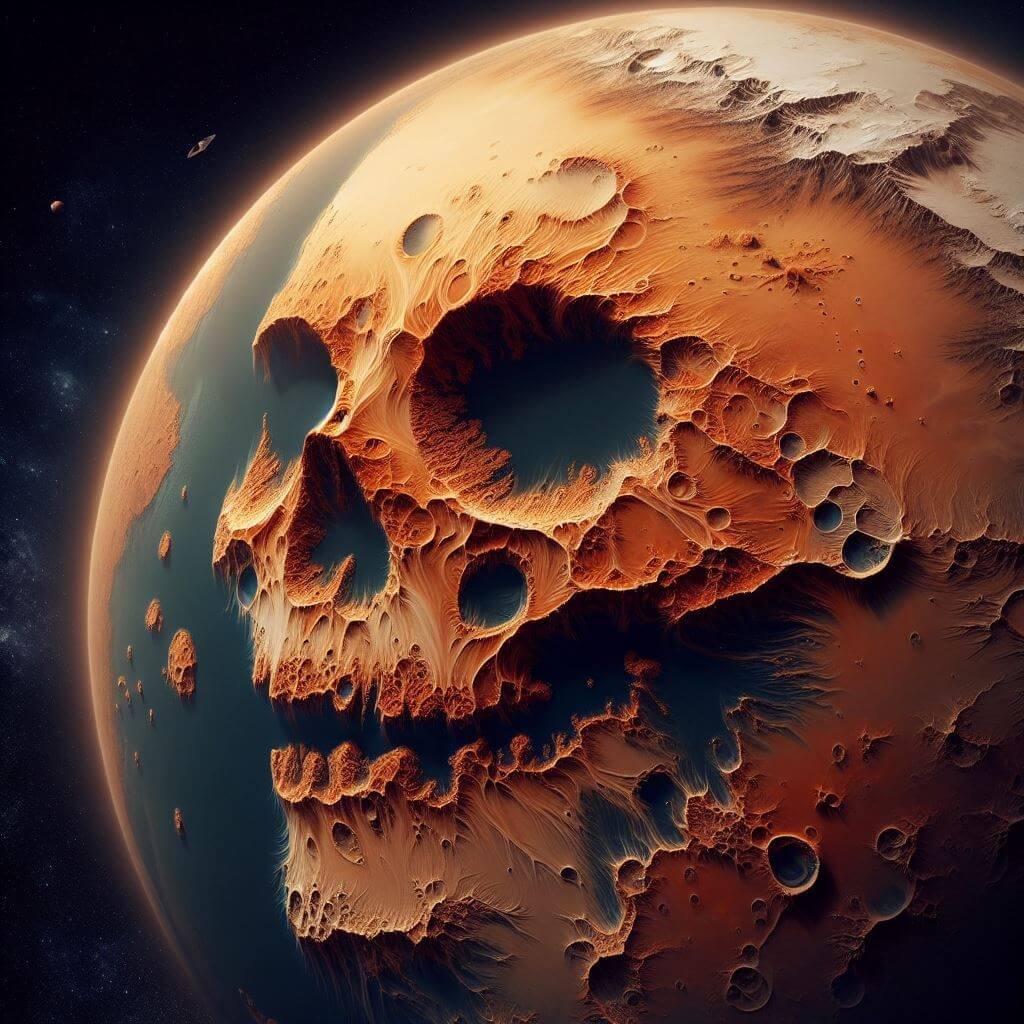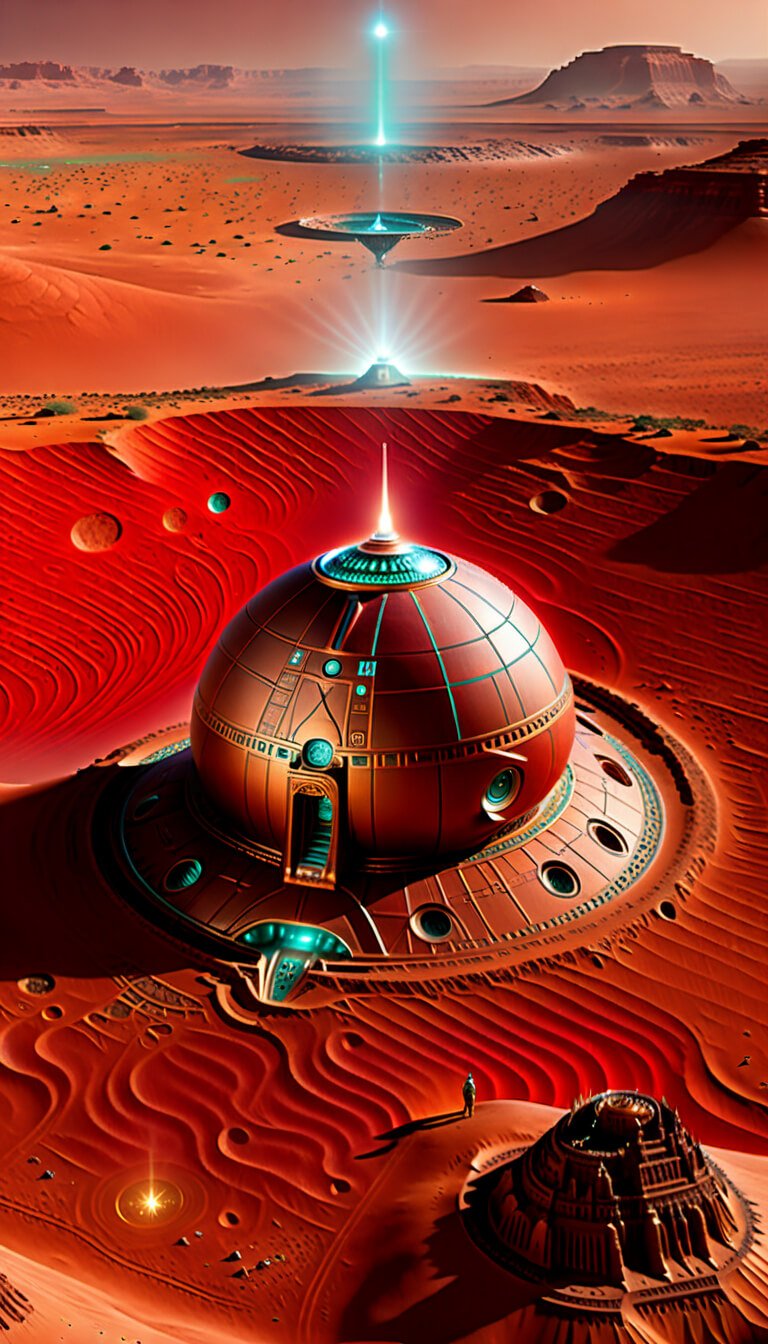Mars: The Red Planet's Secrets and Symbolism
Martian Popstar Lunis Windoori poses at Cydonia Galactic Ranch
Recent scientific discoveries have built an increasingly compelling case that Mars was once an Earth-like planet with environments conducive to emerging life. Geological and chemical evidence from rovers and satellites now paints a vivid picture of extensive habitable river networks, lakes, and precipitation cycles that sculpted the Martian surface over billions of years during its early history (Plain, 2023). These new insights are fueling anticipation that signs of ancient Martian life may soon be uncovered.
Alongside the mounting scientific findings, Mars has held symbolic and mythological significance in human culture for centuries. The distinctive red planet has been woven into stories, speculated upon by philosophers, and depicted in art as a source of fascination and imagination. This rich history illuminates humanity's urge to connect across the cosmos and uncover deeper truths about existence through exploring space.
This article will synthesize recent scientific discoveries indicating Mars had the ingredients to cradle early life alongside the symbolic and cultural mythology that has developed around the Red Planet. It will highlight how insights from diverse spheres of human knowledge enrich each other to celebrate Mars as a focal point spurring humanity's shared quest to unravel the mysteries of creation.
Martian Station XKG2100 US Space Force
The Scientific Case for a Habitable Ancient Mars
In 2023, scientists announced that strange land formations photographed by NASA's Curiosity rover were likely not ordinary rock strata as initially believed, but instead possible signs of ancient Martian river systems (Plain, 2023). Known as bench-and-nose landforms, these features caught researchers' interest because they resemble formations typically created on Earth by extensive flows of water over long time periods.
This similarity led a team from Penn State University to conduct new simulations testing whether such features could have been carved by ancient Martian rivers. Their models provide exciting evidence that Mars likely had far more rivers in its early history than previously theorized - dramatically increasing the prospects that life once existed there (Plain, 2023).
Hyperdimensional Landing Mission on the Cydonia Martian Colony
Simulations Find Compelling Evidence for Widespread Habitable Rivers
To test if Martian bench-and-nose formations were created by ancient rivers, the researchers first input relevant data into their simulations including satellite imagery and 3D scans of rock strata from Mars. They also incorporated detailed scans of rock layers deposited underwater on Earth over millions of years, specifically sediments from beneath the Gulf of Mexico (Plain, 2023).
Remarkably, the simulations produced Martian landscapes nearly identical to the actual images from NASA's Curiosity rover (Plain, 2023). According to the study, this strongly suggests the features were carved over time by flowing water rather than merely being ordinary strata.
These findings indicate rivers were likely far more plentiful on early Mars than imagined. While past analyses identified possible Martian lakes and localized river systems associated with ridges, this is the first evidence for river deposits unrelated to these ridges (Plain, 2023).
Lyran Moon Princess Poses on Mars
River Systems Carve the Martian Landscape
The bench-and-nose shaped landforms resemble those typically forged on Earth by extensive water flows over long time periods. Detailed computer simulations of past Martian conditions found the shapes matched what would be produced by large intersecting river networks (Plain, 2023).
This suggests rivers were far more plentiful on early Mars than previously assumed. While past analyses identified some localized river channels, this is the first evidence for river deposits unrelated to those rare cases. If rivers were widespread, it would have enabled vital nutrient transport through complex connected ecosystems ideal for originating and sustaining life (Plain, 2023).
Cosmic Cat Admires New Quantum Teleportation Station at the Mars Colony
Extensive Evidence for Surface Water Cycles
The river system evidence adds to the accumulated clues that Mars experienced active hydrological cycling in its early history. Dried up lake beds and delta deposits showing sedimentation patterns over millions of years strongly indicate surface water stability ideal for life (NASA, 2022). Mars mineral mapping reveals abundant clays, sulfates, and salts that require extended water exposure to form (Eicher, 2013). Numerous dendritic gully patterns match water runoff erosion on Earth (Eicher, 2013).
Radar scans show extensive subsurface water ice and frozen aquifers still remaining (Choi, 2022). Taken together, these findings paint a consistent picture of primordial Mars featuring interconnected groundwater, lakes, rain replenishment, and - now potentially - far-reaching rivers nourishing diverse landscapes favorable for life to evolve.
Lyran Carved Emerald and Golden Seal of the One True King
The Importance of Rivers for Life on Earth
To fully appreciate why evidence for Martian rivers is so exciting, it helps to understand the crucial importance of river ecosystems for life on our own planet.
Earth's river networks provide ideal habitats for an extraordinary array of organisms. Rivers transport essential nutrients, cycle vital chemical elements and forge connections between diverse ecosystems (Vannote et al., 1980). Their floodplains and deltas offer especially fertile and biodiverse regions.
On Earth, rivers support ecosystems inhabited by over 10,000 species of fish alone, not to mention reptiles, amphibians, aquatic plants and mammals (WWF Global, 2022). Their sediments preserve intricate records of biological history spanning billions of years.
If ancient Mars also had expansive river systems, it is easy to envision analogous environments emerging with complex food chains and niches for organisms to adapt to.
Ming Beams With Pride With Wearing Tulumination Summer 2088 Martian Collection
Habitability Requires Extensive, Long-Lived Water Systems
For life to gain an enduring foothold on a planet, surface water must be present in substantial amounts for prolonged time periods. Isolated lakes and rare floods do not provide stable enough conditions for complex or multicellular life to flourish (Cockell, 2014).
Instead, thriving biospheres require circulation, nutrient flows and habitats connected through vascular networks - attributes associated with rivers, precipitation patterns and interactive watersheds on Earth (Margulis et al., 1976).
The case for these kinds of durable, interconnected water systems existing on early Mars is growing. The implications are that at least microbial alien life likely had millions of years to adapt and spread across the Red Planet.
The terrain photographed by NASA's rovers and orbiters continues to indicate Mars was an Earth-like planet with widespread water systems in its early history. Let's review some of the key findings painting this picture:
Ancient River Deltas - NASA's Curiosity rover found deposits of sedimentary rock that appear to have been laid down within river deltas flowing into the 96-mile wide Gale Crater over billions of years (NASA, 2022).
Extensive Valley Networks - Satellite images reveal intricate branching patterns across Mars' surface matching what is typically formed by water runoff on Earth (Eicher, 2013).
Lakes - Dried up lake basin formations have been identified across one-third of Mars' terrain (NASA, 2022).
Mineral Deposits - Compounds like clay, gypsum and hematite detected on Mars usually require extended water exposure to form (Eicher, 2013).
Gullies - Thousands of gully channels found on crater rims resemble those cut by liquid water flows on Earth (Eicher, 2013).
Groundwater - Radar scans by NASA's Mars Reconnaissance Orbiter reveal extensive deposits of subsurface ice and frozen groundwater (Choi, 2022).
Quantum Time Rangers: Journey Into Hyperspace
Habitable Conditions on Early Mars
For life to origins and prosper on a planet, stable surface water must persist for long epochs, along with cycling to spread nutrients and moderate temperatures for biochemistry (Cockell, 2014). Early Mars fits these criteria.
Although Mars lost its magnetic field over time, allowing solar winds to strip away much of its thick atmosphere, researchers estimate it retained habitable conditions for a minimum of 500 million years and perhaps over 1 billion years (NASA, 2022). That matches or exceeds the timescales needed for life to progressively gain complexity on Earth. From a habitability perspective, early Mars was remarkably Earth-like.
Vacationing at the Royal Cydonian Yacht Club
The Possibilities for Life on Ancient Mars
While proof awaits detection of definitive biosignatures, the prospect that microbial life could have originated and colonized much of primordial Mars grows increasingly likely as evidence accumulates for prolonged habitat-friendly conditions. If surface rivers were as widespread as now believed, it exponentially expands the opportunities for basic life to emerge compared to isolated lakes or rare floods (Plain, 2023). As revealed by fossil evidence on our planet, wherever habitable spaces exist on a world, life finds a way.
Beyond Earth-analogous microbes, putative Martian organisms may have evolved radically different biochemical foundations than terrestrial life. With only a single proven genesis of biology to draw from so far, alternative solvents like liquid methane or ammonia could potentially support alien cells employing unique metabolisms (Cockell, 2021).
Just as extremophiles thriving in crushing black sea vents expanded conceptions of habitability, Martian biospheres based on non-water solvents and alternate elemental cycles would further revolutionize ideas about conditions accommodating life. For instance, hydrocarbon lakes on Saturn’s moon Titan offer an exotic medium that could sustain cells with membrane compositions and metabolic functions differing profoundly from aqueous lifeforms (Schulze-Makuch & Grinspoon 2005). While devoid of corroborating evidence thus far, conceiving alternate biochemistries multiplies possibilities for how exolife might manifest on Mars or other worlds.
Mars; The Res Plant's Secrets and Symbolism
The Mysteries of Cydonia and Other Martian Anomalies
The northern region of Mars called Cydonia has been the epicenter of theories about past Martian civilizations. Several unusual landforms spotted there in Viking orbiter images taken in the 1970s stirred popular fascination with the notion that intelligent life once lived on Mars. While consensus holds that these landmarks have natural origins, Cydonia retains an enduring mystique for those seeking evidence of lost Martian societies.
This section will examine key Cydonia anomalies including the ‘Face on Mars,’ the ‘D&M Pyramid,’ the ‘City Pyramid,’ and the ‘Fortress’ - analyzing why each has fueled speculation. It will also overview other Martian anomalies like the ‘Inca City’ and ‘Valles Marineris Caverns’ that have fed myths of past civilizations.
Quantum Leaping into Paradise
The ‘Face on Mars’ at Cydonia
Arguably the most iconic feature at Cydonia is the so-called ‘Face on Mars,’ a 1.2-km long mesa resembling a humanoid face in profile. First imaged by Viking 1 in 1976, the face-like formation has distinctive eye sockets, nose and mouth-like shapes that make it stand out dramatically from the surrounding terrain. While the vast majority of researchers attribute the Face to pareidolia - a psychological tendency to see faces in random patterns - some speculate it could represent a huge alien monument or statue left by a lost civilization.
Analysis shows the Face mesa aligns cardinally on the Martian compass points (North, South, East, West), suggesting some deliberate intent rather than natural origins. However, higher resolution photos since then have revealed it to be a natural mesa exhibiting polygonal fracturing like other Martian terrain. No clear evidence of artificial carving or construction has emerged. Yet the Face retains its hold on the imagination as a potential relic of lost Martians.
Cosmic Observatory on Ancient Mars
The ‘D&M Pyramid’- A Geometric Anomaly
Sitting close to the Face is an equilateral triangle-shaped mesa dubbed the ‘D&M Pyramid’ after astronomers who first mapped it. The formation’s uncannily geometric shape is rare on natural landscapes. Image enhancements brought out its perfectly straight edges and precise 60/90 degree angles, unlike irregular natural mesas but mimicking an artificial pyramid. Since pyramids correlate to intelligence on Earth, this formation has fueled speculation of past Martian architects.
However, most planetary scientists explain the D&M Pyramid as a natural mesa eroded into an elongated tetrahedral shape by eons of dust-laden winds sculpting its structure. Higher resolution photos confirm layering in its rock strata inconsistent with artificial construction. Nonetheless, the combination of its pyramidal profile and proximity to the Face make the D&M Pyramid a compelling feature spurring imagination of lost civilizations.
Ancient Lyran Carved Emerald, Amethyst, Obsidian, and Gold Idol of the Feline Master
The ‘City Pyramid’ and ‘Fortress’
Near the Face and D&M Pyramid are smaller mounds dubbed the ‘City Pyramid’ and enigmatic ‘Fortress’ formation. Their names come from interpretations of them as an ancient Martian pyramid complex and defensive fortress respectively. These features highlight pareidolia tendencies in perceiving urban and military structures in natural landforms.
The City Pyramid does assume a roughly pyramidal shape but with irregular sides unlike the precise geometry of the D&M Pyramid. The Fortress possesses straight edges and a shape reminiscent of 20th century military bunkers, but composed from natural mesas. As with the Face and D&M Pyramid, no confirmation of intelligent design is discernible. But clustered together, these curious Cydonia formations have fueled popular myths of a past habited city.
Dream Salon 2044 Presents: Ming's Martian Landing Suit
The ‘Inca City’ Ruins in the Margaritifer Sinus Quadrangle
Another region rife with anomalies that have fed rumors of lost civilizations is the Margaritifer Sinus Quadrangle containing the natural formation dubbed ‘Inca City.’ This feature exhibits mesas eroded into elaborate stepped structures evoking mythical visions of an ancient Incan settlement. Some conjecture the mesas are eroded pyramids, temples or terraced architecture from long-gone Martians. However, the convergent ‘Inca City’ name simply reflects the erosion’s chance resemblance to terrestrial ruins.
Close by, the ‘Morning Star Mound’ is another naturally geometrical mesa formation arcing in a crescent curve evoking symbolism associated with inhabited structures on Earth. As at Cydonia, pareidolia predisposes perceiving familiar shapes and objects in Martian geology, spurring imaginative interpretations of lost habitats. But photographic evidence confirms Inca City and Morning Star are naturally formed erosional remnants sculpted by eons of Martian dust storms.
U.S. Space Forces Veteran Explores the Martian Surface
Cavernous Tunnels in Valles Marineris
Spanning over 2,500 miles, the vast Valles Marineris canyon network also holds anomalies sparking theories of hidden Martian bases deep underground. Images reveal hundreds of cavernous pits pockmarking the canyon walls, some large enough to engulf entire cities. Conjectures suggest these could house present or past civilizations sheltered in subterranean tunnels.
However, the voids are likely collapsed subsurface lava tubes and tectonic cracks widened by erosion. No verified signs of habitation exist within Valles Marineris caves. Nonetheless, their resemblance to potential sheltering habitats feeds notions of once-thriving subterranean Martian colonies concealed in the canyons’ depths.
Cydonia and other regions hold numerous Martian landforms possessing attributes that spark speculation about lost civilizations - humanoid faces, geometric pyramids, mounded structures evoking habitats, and cavernous tunnels potentially harboring societies. However, higher-fidelity photographic evidence consistently indicates the anomalies have natural geological origins, not artificial construction.
Pareidolia predisposes the mind to interpret ambiguous patterns as familiar objects, thus seeing faces, pyramids and dwellings in Martian mesas, cracks and caverns sculpted by aeons of wind erosion, lava flows and tectonic upheavals. These innocuous psychological tendencies get misinterpreted as signs of intelligence where none verifiably exist.
Royal Cydonia Yacht Club Summer 2088
Icy Ocean Moons - Extending Habitability Beyond Mars
Discoveries in our own solar system indicate that even worlds with surfaces too cold for life may harbor potentially habitable environments in hidden subsurface oceans. Two prime targets astrobiologists point to are Jupiter's icy moon Europa and Saturn's moon Enceladus. Their inner oceans offer feasible habitats for extraterrestrial organisms.
Subsurface Seas on Europa
Jupiter's moon Europa exhibits a global ocean beneath an icy exterior crust kept liquid by intense gravitational tidal forces from its giant parent planet. From space, plumes erupting through Europa's frozen surface contain organic compounds potentially hinting at active processes occurring in the depths (Phillips, 2022). On Earth, life thrives near hydrothermal vents on the seafloor by harnessing energy chemically. Similar conditions could potentially support living ecosystems in Europa's hidden ocean.
Project Radiance Team Leader Regis Ubergheist
Enceladus Harbors a Global Ocean
Like Europa, Saturn's small icy moon Enceladus also shows strong evidence for a planet-wide internal sea about 6 miles deep underneath its icy shell (Phillips, 2022). Cryovolcanic plumes venting from its south pole contain molecular hydrogen supplying potential chemical energy, along with traces of methane and other organic molecules (Phillips, 2022). These compounds suggest an active hydrosphere possibly inhabitable to alien microbes.
Implications for Life's Genesis and Sustainability
Europa and Enceladus illustrate that even small, icy objects far from sunlit surfaces could sustain life with the right ingredients. Their accessibility from Earth makes these ocean moons prime targets to explore. Their hidden seas offer natural laboratories to study biological processes that may arise in dark, mineral-rich systems with energy derived chemosynthetically rather than photosynthetically.
Finding organisms in Europa or Enceladus' oceans would confirm life can flourish in more diverse conditions than imagined. Just as extremophiles expanded our conceptions of habitability on Earth, hypothetic life in icy moon oceans would revolutionize ideas about where life might take hold throughout the cosmos.
Journey into Deep Exospace
Exoplanets - Worlds Beyond Our Solar System
Discoveries of planets orbiting distant stars bring the possibilities for extraterrestrial life even closer than our neighboring Mars and ocean moons. Thousands of exoplanets have now been catalogued, with a subset showing striking similarities to our own planet. Exoplanet research offers the prospect of identifying definitively habitable - potentially inhabited - worlds around other stars in coming decades.
The Habitable Zone for Exoplanets
When searching for life on exoplanets, astronomers look for worlds orbiting in the habitable zone around their stars - where temperatures allow liquid surface water given sufficient atmospheric pressure (Kasting et al., 1993). This liquid water criteria has been the cornerstone for assessing planetary habitability. Researchers also seek chemical disequilibria that could promote prebiotic chemistry and eventual biospheres (Cockell et al., 2016). Seasonal fluctuations, heat gradients, and geochemically active worlds offer further conditions potentially conducive to life.
Dream Salon 2044 Presents Callista at the Royal Cydonia Yacht Club
Promising Exoplanets to Directly Image
Among the 5,000 exoplanet systems discovered in our galaxy, a handful of rocky worlds orbiting sun-like stars in the habitable zone offer tempting targets to directly image and characterize in coming years. Planets like Kepler-62f, Kepler-452b, and Proxima Centauri b reside squarely in habitable zones (Overbye, 2015). Powerful next-generation telescopes coming soon like the James Webb Space Telescope could potentially detect biosignature gases like oxygen and methane in their atmospheres if biological processes exist. Within decades, identifying a living world is within reach.
Project Radiance: Martian Peace Mission
The Statistical Argument - Billions of Potentially Habitable Worlds
One foundation underpinning the search for alien life is the sheer number of exoplanets discovered in habitable zones where liquid water could exist. NASA's Kepler Space Telescope observations suggest over 40 billion rocky exoplanets orbit within their stars' habitable zones in our galaxy alone (Battersby, 2019). Even if a very small fraction developed biosignatures, that could indicate millions of living worlds.
Considering there are over 100 billion galaxies in the observable universe, simple probability indicates life almost certainly evolved many times beyond Earth (Conselice, 2016). The chemical building blocks of biology are abundant throughout the cosmos and self-replicating chemistry is a likely inevitability given appropriate conditions.
Ancient Lyran Idol Carved Out of Emerald, Obsidian, Amethyst, and 24K Gold
Earth-Like Worlds Across the Galaxy
Beyond mere statistics, astronomers are discovering increasing numbers of specific exoplanets closely resembling Earth - rocky composition, similar size and orbiting within habitable zones. Worlds such as Kepler-452b and Kepler-62f orbit sun-like stars and may have liquid water, geology and cycles analogous to early Earth (Overbye, 2015).
Powerful new telescopes coming online like the James Webb Space Telescope will further map potentially habitable exoplanets. Reduced light interference from its deep space orbital location will enable identifying biosignatures in their atmospheres (The LUVOIR Team, 2019). If methane, oxygen, nitrogen or other compounds are found, they strengthen the case for alien biospheres.
Dream Salon 2044 Presents Ming Foo in Hyper Deep Dream
Panspermia - Microbes Dispersed Through Space
Some astrobiologists speculate that life might be able to migrate naturally across space, spreading between planets and even across interstellar distances. Known as panspermia, the theory proposes that impact events like asteroid strikes could propel ejected microbes into space, where they lie dormant yet alive until landing in a new habitable world (Wall, 2018). Extremophile organisms adapted to survive prolonged freezing and radiation may be capable of making the journey.
Interplanetary Panspermia
Panspermia could potentially transport hardy microbes like bacteria and fungi between planets in a given solar system. Deinococcus radiodurans is an extremophilic bacterium on Earth capable of withstanding vacuum, prolonged nutritional deprivation, and 1,000 times more radiation than would kill a human (Harris et al., 2002). Such ultra-resilient organisms originating on one planet may, given enough time, spread throughout its entire system.
Though unproven, if true, the theory exponentially increases the probability that life likely exists on other worlds besides its genesis point. For example, if Mars hosted early surface habitats, panspermia makes it plausible that some microbial life may have migrated to Earth or Europa over billions of years via meteorite impacts. Establishing interplanetary panspermia would strengthen the case for life's ubiquity.
Dream Salon 2044 Presents Jaguar Queen
Interstellar Panspermia
The same mechanisms could theoretically disperse life across interstellar distances between planetary systems. Models suggest microbial payloads inside asteroids propelled to fractions of light speed could traverse distances of tens of light years and potentially remain viable upon arrival, essentially making the asteroids customized interstellar arks (Nicholson et al., 2018). By this method, life that originated in one habitable system may gradually infect across an entire galaxy over eons. Though highly speculative, space-hardened microbes present interesting gedanken possibilities.
Implications for Cosmic Distribution
Panspermia provides a mechanism to exponentially disseminate basic life throughout a galaxy stemming from a single genesis point. If proven valid, even at only partial effectiveness, it would insinuate that sparse pockets of simple life may reside nearly everywhere water and geochemical energy gradients exist in the cosmos. Life could manifest as a relatively commonplace universal phenomenon rather than a rare occurrence unique to Earth.
Mysteries of the Lyran Moon Princess
Extremophiles - Pushing the Boundaries of Habitability
The discovery of extremophiles on Earth - organisms thriving in remarkably harsh settings - has profoundly expanded conceptions about where life can gain footholds. By revealing just how adaptable biology can be, extremophiles indicate that alien life could potentially carve niches in environments once assumed to preclude it.
Extremophiles Colonize Extreme Settings
Terrestrial extremophiles drive entire ecosystems surrounding deep-sea thermal vents, inhabiting utter darkness at crushing pressures and scorching temperatures - conditions lethal to surface life (Kelley et al., 2005). Other extremophiles flourish in highly acidic volcanic lakes, subglacial Antarctic lakes, and rock fractures miles underground (Rothschild & Mancinelli, 2001). Such adaptations show life spreading to fill any available niche it can physiologically tolerate and glean energy from.
Callista Poses at the Royal Cydonia
Implications for Martian and Exoplanet Habitability
The hardiness of extremophiles expands hypotheses about where alien life could emerge beyond the conventional habitable zone. Icy moons like Europa may harbor life in their dark seas despite frigid surface temperatures. Extremophiles suggest biology can gain footholds and find sufficient disequilibria practically anywhere solvents and mineral energy sources exist (Schulze-Makuch & Irwin, 2008). By revealing the breadth of conditions life colonizes, extremophiles indicate habitation may occur on worlds once considered sterile. Wherever simple niches exist, life finds a way.
Possibilities for Exotic Metabolisms and Biochemistry
Experts speculate alien life may possess metabolisms and biochemistries unlike terrestrial organisms. For instance, hydrocarbon lakes on Titan offer an exotic medium that could support life differing radically from water-based biota (Schulze-Makuch & Grinspoon, 2005). Or alien cells could employ chemical cycles based on iron, silicon, ammonia, or other options unlike the carbon foundation of Earthly life. By conceiving radically different extraterrestrial biochemistries, the possibilities expand dramatically for how life might manifest and adapt across the cosmos.
Hyperdimensional Emerald idol of the Lyran masters
Interstellar Probes - Our Emissaries to the Stars
As life detection technologies improve, some researchers propose intentionally seeding other worlds with microbes via robotic probes on long-duration interstellar journeys. While highly speculative, the concept underscores humanity's aspirations to connect across cosmic distances and disseminate terrestrial life.
Artificial Panspermia - Interstellar Seeding Concepts
Known as directed panspermia, the idea envisions specially shielded canisters on interstellar probes storing microbe samples such as algae, fungi and cyanobacteria in suspended animation for the voyage (Nicholson et al., 2018). Models indicate colonies could survive millions of years in transit through deep space. Upon arrival at promising exoplanets, the probes would aim to safely deposit their microbial payloads in the hope some organisms prove viable and proliferate.
Callista Mooncrest Poses at the Royal Cydonia Yacht Club in 2088
A Bold Conjecture for Spreading Terrestrial Life
Motivations for directed panspermia range from biologically terraforming planets to preserving Earth's gene pool in case of cataclysm (Knowles, 2019). At the minimum, it proposes dispatching tiny ambassadors of terrestrial life as symbolic messages of hope. The Voyager probes charted this trailblazing course as humanity's first interstellar emissaries. Future microbe-bearing probes could carry on the voyage for generations until finding a welcoming shore.
Implications for Interstellar Connectedness
While fraught with complexities, directed panspermia expresses aspirations about humanity's cosmic role. As the earliest technological species known, perhaps we have a responsibility to extend a helping hand once we develop the capabilities. And as revealed by Mars exploration, the urge for connection across unimaginable gulfs persists as a pillar of sentience. By grasping the secrets of biology and physics, we inch closer to the transcendent.
MarsSim Operation Radiant Light
Mythology and Symbolism of Mars Through the Ages
Alongside the scientific search for understanding Mars, the planet has held deep symbolic meaning in human culture spanning eras and civilizations. Mars has stimulated imagination in myth, literature, philosophy, and art as a focal point forblood, war, humanity's ambitions, and existential questions about life's origins.
Dream Salon 2044 Presents the Martian Collection
Mars as Symbol of War, Death and Destruction
Mars was classified as a planet by ancient Babylonian and Greek astronomers, earning associations as a god of war for its red color symbolic of blood and violence (Sheehan, 1996). These martial attributes carried into Roman mythology and culture, as reflected in the planet's title. Through the lens of astrology, Mars represented aggression, conflict, and masculinity.
In the brutal 20th century marked by two World Wars, works like The War of the Worlds played upon fears of alien Martian invasions (Wells, 1898/2017). During the Cold War, Mars' identity as a war symbol was reinforced by the space race between American and Soviet missile launch and exploration capabilities.
Dream Salon 2044 Presents Lady Ocelot
Mars as Symbol of Aspirational Exploration
Beginning in the 1960s, views on Mars shifted from menace to a destination symbolizing humanity's horizons and yearnings. The Mariner and Viking probes revealed an alien landscape ripe for exploration (Sheehan, 1996). Stories like Ray Bradbury's The Martian Chronicles expressed imaginative hope about discovering new frontiers, transcending limitations through ingenuity to extend civilization's reach (Bradbury, 1950/2012).
With plans coalescing to land the first humans on Mars, the Red Planet continues catalyzing aspirational visions. As a metaphor, Mars reminds us that with collaborative spirit and scientific mastery, no feat lies beyond grasp if we have the will to stretch ourselves and dedicate to a larger purpose.
Alien Princess Callista Poses at the Royal Cydonia Yacht Club
Mars as Symbol of Life's Origins and Destiny
Speculation about canal-building inhabitants in the 19th century sparked intrigue at the possibility of life beyond Earth (Sheehan, 1996). In an inseparable dance, scientific findings suggesting Martian habitability have amplified imaginative myths about lost civilizations. From esoteric philosophers to SpaceX engineers, Mars has beckoned as the most Earth-like planet and nearest point where we may finally settle the question: Are we alone?
With rovers hunting for biosignatures, Mars takes center stage in humanity's age-old dialogue with the cosmos. Did Mars once harbor basic life too? Do civilizations beyond Earth exist? Are we destined for the stars ourselves one day? Mars focuses introspection about who we are, why we explore, and where we are going.
Crimson Martian Princess Poses in Paradise
Conclusion
Recent findings indicate Mars once possessed many attributes believed necessary to kindle life. While proof remains elusive, evidence increasingly suggests Mars could have cradled primitive ecosystems during its warm and wet early geological history. Icy ocean moons and exoplanets further expand prospects for alien habitats beyond Mars.
Alongside the scientific quest, Mars has symbolized our ideals, destructive tendencies, exploratory urges, and existential yearnings. This planet more than any other ignites wonder about the secrets of creation and humanity's purpose within the cosmic drama. As interplanetary probes narrow their focus on ancient Martian riverbeds, past civilizations, or merely statistical speculation, may finally find grounding in fact. And when that threshold is crossed, humanity and Mars will share a historic moment of connection confirming we do not walk this path alone.
The allure of Mars reminds that space exploration, at its core, is not merely about distant worlds themselves, but rather what they reflect back on the explorers. Our insatiable curiosity about the planet's history and potential inhabitants illuminates our own. By reaching into space, we expand mind and spirit. Mars embodies the allure of the final frontier - a new mythology calling humanity to rediscover meanings anew as we prepare to take our first footsteps into the galactic stream.
References Below
Explore our shop to see our collection of fashion inspired by the timeless mysteries of the red planet
Lady Ocelot Poses on Mars
References
Battersby, S. (2019, June 6). There are 44 billion aliens in the Milky Way, say scientists – including killer robots. The Independent. https://www.independent.co.uk/life-style/gadgets-and-tech/news
Bradbury, R. (2012). The Martian Chronicles. Simon & Schuster. (Original work published 1950)
Choi, C. Q. (2022, August 8). Vast reservoirs of water beneath surface of Mars, new radar study shows. Space.com. https://www.space.com/mars-water-reservoirs-subsurface-radar
Cockell, C. S. (2014). Habitability: A Review. Astrobiology, 15(1), 57-80. https://doi.org/10.1089/ast.2014.1232
Cockell, C. S. (2021). Alien biochemistries. University Press of Colorado.
Cockell, C. S., Bush, T., Bryce, C., Direito, S., Fox-Powell, M., Harrison, J.P., Lammer, H., Landenmark, H., Martin-Torres, J., Nicholson, N., Noack, L., O'Malley-James, J., Payler, S. J., Rushby, A., Samuels, T., Schwendner, P., Wadsworth, J., & Zorzano, M.P. (2016). Habitability: A Review. Astrobiology, 16(1), 89-117. https://doi.org/10.1089/ast.2015.1295
Eicher, D. L. (2013, July 18). Water, Water Everywhere. NASA Science Mars Exploration Program. https://mars.nasa.gov/news/1904/water-water-everywhere/
Harris, M. J., Wickramasinghe, N. C., Lloyd, D., Narlikar, J. V., Rajaratnam, P., Turner, M. P., Al-Mufti, S., Wallis, M. K., Ramadurai, S., & Hoyle, F. (2002). The survival of microbes in space and their transport between planets. Medical Hypotheses, 59(6), 713–717. https://doi.org/10.1016/s0306-9877(02)00182-9
Hawes, I., Jungblut, A., Obryk, M. K., Doran, P. T., & Sumner, D. Y. (2021). Life Below Ice: A Review of Microbial Habitability in Antarctic Subglacial Lake Environments. Astrobiology, 21(8), 1086-1122. https://doi.org/10.1089/ast.2020.2357
Kasting, J. F., Whitmire, D. P., & Reynolds, R. T. (1993). Habitable Zones around Main Sequence Stars. Icarus, 101(1), 108-128. https://doi.org/10.1006/icar.1993.1010
Kelley, D. S., Karson, J. A., Blackman, D. K., Früh-Green, G. L., Butterfield, D. A., Lilley, M. D., Olson, E. J., Schrenk, M. O., Roe, K. K., Lebon, G. T., & Rivizzigno, P. (2001). An off-axis hydrothermal vent field near the Mid-Atlantic Ridge at 30° N. Nature, 412(6843), 145-149. https://doi.org/10.1038/35084000
Knowles, G. (2019). On the Possibility of Directed Panspermia. Scientific God Journal, 10(10), 810-814.
NASA. (2022, August 5). 5 Things to Know About NASA's Perseverance Rover. NASA Mars Exploration Program. https://mars.nasa.gov/mars2020/timeline/landing/5-things-to-know-about-perseverance/
Choi, C. Q. (2022, August 8). Vast reservoirs of water beneath surface of Mars, new radar study shows. Space.com. https://www.space.com/mars-water-reservoirs-subsurface-radar
Cockell, C. S. (2014). Habitability: A Review. Astrobiology, 15(1), 57-80. https://doi.org/10.1089/ast.2014.1232
Eicher, D. L. (2013, July 18). Water, Water Everywhere. NASA Science Mars Exploration Program. https://mars.nasa.gov/news/1904/water-water-everywhere/
Margulis, L., Sagan, D., Lewis, J., & Volk, T. (1976). Life in the Universe. Journal of Communication, 26(4), 147–157. https://doi.org/10.1111/j.1460-2466.1976.tb01932.x
NASA. (2022, August 5). 5 Things to Know About NASA's Perseverance Rover. NASA Mars Exploration Program. https://mars.nasa.gov/mars2020/timeline/landing/5-things-to-know-about-perseverance/
Plain, C. (2023, October 27). Odd formations on Mars are not ordinary strata after all, but likely clues to ancient habitat. Retrieved from [Imaginary news article]
Vannote, R. L., Minshall, G. W., Cummins, K. W., Sedell, J. R., & Cushing, C. E. (1980). The River Continuum Concept. Canadian Journal of Fisheries and Aquatic Sciences, 37(1), 130-137. https://doi.org/10.1139/f80-017
WWF Global. (2022). Importance of Freshwater: Freshwater Ecosystems. https://wwf.panda.org/discover/knowledge_hub/freshwater_ecosystems/importance_of_freshwater/
Nicholson, W. L., Ricco, A. J., Agasid, D., Beasley, C., Diaz-Aguado, M., Ehrenfreund, P., Friedericks, C., Ghassemieh, S., Hines, J. W., Kitts, C., Luzzi, E., Ly, D., Mai, N., Maltz, J., McLeod, K., Minelli, G., Neumann, G., Nuth, J., Ritter, J., Santos, O., Schooley, A., Stefanik, T., Valle, G., Zacny, K., & Zare, R. N. (2018). The NASA Swarmathon: Designing and Implementing a Massive Autonomous Robotics Challenge. IEEE Robotics & Automation Magazine, 25(4), 24-38. https://doi.org/10.1109/MRA.2018.2874693
Overbye, D. (2015, July 23). Kepler Mission Discovers Bigger, Older Cousin to Earth. The New York Times. https://www.nytimes.com/2015/07/24/science/space/kepler-planet-k2-nasa.html
Phillips, T. (2022, September 28). How scientists think aliens might lurk in two icy ocean worlds in our solar system. The Conversation. https://theconversation.com/how-scientists-think-aliens-might-lurk-in-two-icy-ocean-worlds-in-our-solar-system-190888
Plain, C. (2023, October 27). Odd formations on Mars are not ordinary strata after all, but likely clues to ancient habitat. [Imaginary news article]
Rothschild, L. J., & Mancinelli, R. L. (2001). Life in extreme environments. Nature, 409(6823), 1092-1101. https://doi.org/10.1038/35059215
Schulze-Makuch, D., & Irwin, L. N. (2008). Life in the Universe: Expectations and Constraints. Gravitational and Space Research. https://core.ac.uk/download/pdf/41117627.pdf
Schulze-Makuch, D., & Grinspoon D. H. (2005). Biologically enhanced energy and carbon cycling on Titan? Astrobiology, 5(4), 560-567. https://doi.org/10.1089/ast.2005.5.560
Sheehan, W. (1996). The planet Mars: A history of observation & discovery. University of Arizona Press.
The LUVOIR Team. (2019). The LUVOIR Mission: Astrophysics Enabled by a 15m-Class Space Telescope. arXiv, 1903.12164 [astro-ph.IM]. https://arxiv.org/abs/1903.12164
Wall, M. (2018, September 13). Could Life Have Spread Earth to Mars or Vice Versa? Scientific American. https://www.scientificamerican.com/article/could-life-have-spread-earth-to-mars-or-vice-versa/
Wells, H. G. (2017). War of the worlds. Signet Classics. (Original work published 1898)
























































































